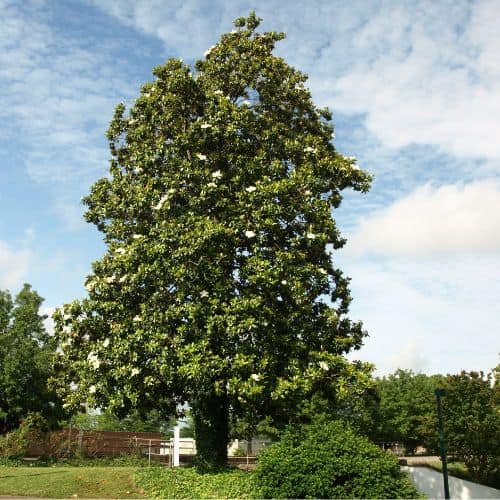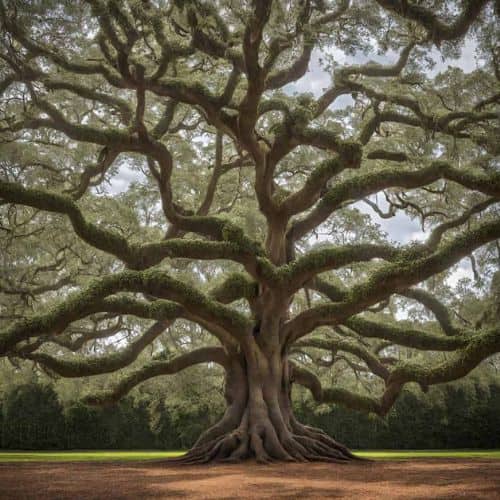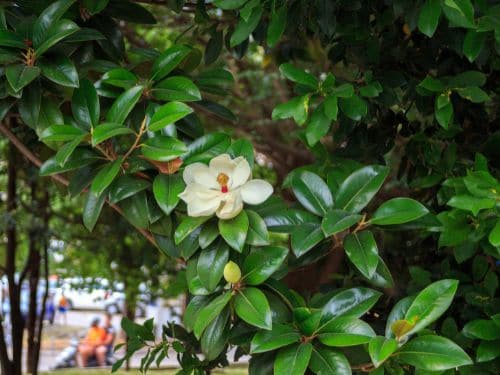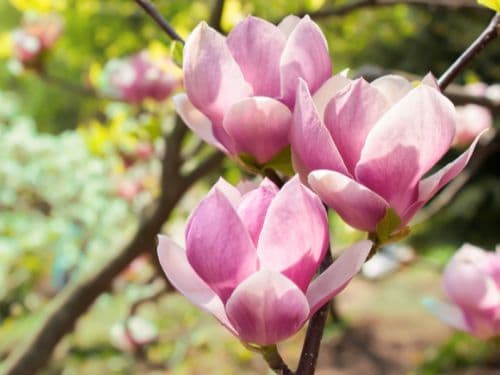With their exquisite blossoms and lush foliage, Magnolias are iconic symbols of beauty and grace in gardens worldwide. Belonging to the Magnoliaceae family, these trees encompass a diverse range of species and cultivars, each offering unique characteristics. From the iconic Southern Magnolia with its glossy evergreen leaves to the enchanting blossoms of the Star Magnolia, these trees have captured the imagination of garden enthusiasts across the globe.

Growing & Caring for Magnolias
Magnolias thrive in well-drained soil that is rich in organic matter. While they are adaptable to various soil types, consistent moisture is essential, especially during dry periods. Magnolias generally prefer slightly acidic to neutral soil pH.
Magnolia trees are known for their preference for slightly sheltered locations. Plant them in areas with protection from harsh winds to prevent damage to their delicate blossoms and maintain their branches’ integrity. Full to partial sunlight is ideal for optimal growth and flowering, although some varieties can tolerate partial shade.
These trees benefit from a layer of organic mulch around the base to retain soil moisture, suppress weeds, and regulate temperature. Avoid planting magnolias too deeply, as their roots should be close to the surface. Regular watering, especially during dry spells, is crucial for young trees and those experiencing drought conditions.
Uses in the Garden
These trees are commonly used as focal points in gardens, drawing attention and admiration with their stunning blooms. Magnolias work well as standalone specimens or as part of mixed plantings, where their distinct beauty complements other shrubs, trees, and perennials. Magnolias also serve as effective shade trees, providing cooling relief during the warmer months. The broad, glossy leaves create a dense canopy, making them ideal for inviting outdoor spaces for relaxation and socializing.
Size and Shape
Magnolia trees come in a wide sizes and shapes, making them suitable for various garden settings. The Southern Magnolia is known for its large size, reaching heights of 60 to 80 feet with a spread of 30 to 50 feet. On the other hand, smaller varieties like the Saucer Magnolia (Magnolia × soulangeana) typically grow to a more manageable height of 20 to 25 feet.
The growth habit varies from pyramidal to rounded, depending on the species and cultivar. Some magnolias are more upright, while others develop a spreading canopy. The shape of magnolia flowers also varies, with some having a classic cup-and-saucer form while others display a more open and star-like appearance.
The growth rate of magnolia trees is generally moderate, and their long lifespan adds to their value in the garden. With proper care, magnolias can live for decades, becoming cherished focal points in landscapes.

Leaves, Bark, and Flowers
Magnolia leaves contribute to the tree’s overall appeal, providing a lush backdrop to its spectacular flowers. The leaves are typically large, glossy, and leathery, varying in shape from elliptical to obovate. The foliage is deciduous for many magnolia species, shedding in the fall and revealing attractive bark patterns.Magnolia bark is smooth and gray, often developing interesting textures as the tree matures. When the leaves have fallen in winter, the unique bark patterns become more pronounced, adding visual interest to the winter landscape.

The branches of magnolia trees add to their architectural interest. Some magnolias, such as the Star Magnolia (Magnolia stellata), have a more open, multi-stemmed habit, while others, like the Southern Magnolia, develop a more pyramidal form with a single dominant trunk. Pruning, if necessary, should be done with care to preserve the natural shape and structure of the tree. One of the primary attractions is their spectacular blossoms. Magnolia flowers are often large, showy, and fragrant, creating a breathtaking display in early to mid-spring. The color palette includes shades of white, pink, purple, and even yellow, depending on the species and variety.

History of Magnolias
The Magnoliaceae family is one of the most ancient plant families, with fossils dating back over 95 million years. The first magnolias were believed to have originated in Asia, with their natural range extending from the Himalayas to East Asia. Over time, magnolias found their way to other parts of the world, including North America.
The Southern Magnolia (Magnolia grandiflora) holds particular cultural significance in North America. Native to the southeastern United States, this evergreen magnolia with its large, fragrant flowers has become a symbol of the region’s charm and hospitality. It has been featured in South literature, art, and gardens.
The Japanese Magnolia (Magnolia × soulangeana), a hybrid between M. denudata and M. liliiflora, is another notable species with a rich cultural history. It was first cultivated in the 19th century in France by Étienne Soulange-Bodin, and its popularity quickly spread throughout Europe and beyond.
Frequently Asked Questions
What Does A Magnolia Flower Symbolize?
Magnolia flowers carry various symbolic meanings across different cultures and contexts, but some common symbolic associations include:
- Magnolia flowers are often seen as symbols of beauty, elegance, and purity. Their large, showy blooms and graceful appearance evoke admiration and appreciation for natural beauty.
- They are also known for their resilience and ability to thrive in challenging conditions. As such, magnolia flowers can symbolize strength, endurance, and the ability to overcome obstacles.
- In many cultures, magnolia flowers are deeply associated with femininity and gentleness. Their delicate petals and soft fragrances evoke qualities traditionally linked to femininity, such as grace, sensitivity, and nurturing.
- Magnolia flowers are often used in floral arrangements for special occasions such as weddings, graduations, and anniversaries. Their presence can symbolize joy, happiness, and celebration.
Should I Cover My Magnolia Tree In Winter?
If your region experiences extreme cold snaps or temperature fluctuations during winter, it may be wise to provide protection for your magnolia tree. If you live in a region with mild winters and your magnolia is a hardy species, your Magnolia tree will likely not require protection.
Some species of magnolia, such as the Southern magnolia (Magnolia grandiflora), are more cold-hardy than others. However, winter protection may be beneficial if you live in a colder climate or have a less cold-hardy species or cultivar. Newly planted magnolia trees are more susceptible to cold damage than established trees. If your magnolia tree is still young or has been recently planted, it may benefit from winter protection, such as wrapping the trunk with burlap or applying a layer of mulch around the base to insulate the roots.
Are Magnolia Trees Prone To Pests And Diseases?
Magnolia trees are relatively resistant to pests and diseases. However, they can be susceptible to scale insects, aphids, and fungi. Regular monitoring and appropriate care, including proper watering and soil management, can help prevent these problems.
How Fast Do Magnolia Trees Grow?
The growth rate of magnolia trees is generally moderate. Young trees may exhibit faster growth, but the growth rate stabilizes as they mature. Providing optimal growing conditions, including proper soil, sunlight, and water, can encourage healthy growth.
